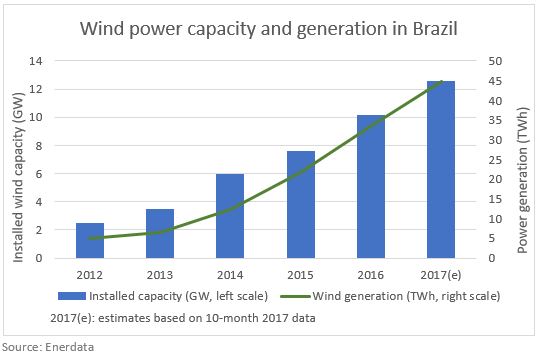Wind power generation increased ninefold over the past five years.
Based on our first estimates for 2017, wind power capacity and generation continued to soar in Brazil in 2017. After a 2.5 GW increase in 2016, wind power capacity is estimated to have surged by 24% in 2017 and wind generation is expected to near 45 TWh in 2017, i.e. 9 times the 2012 level and twice the 2015 level. Wind already accounted for 6% of the power mix in 2016 (from 4% in 2015), closer to the shares of natural gas and biomass (9% each) as complement for hydropower generation (66% of the mix).

According to the draft Plan for Energy Expansion (PDE) unveiled in 2017, wind power capacity should reach 28.5 GW by 2026 (16% of the installed capacity) and should account for 12% of the power mix with 111 TWh.
Several large projects are under construction (3.8 GW) or were approved (2.8 GW) following the recent auctions. The Government approved 53 renewable power projects in the 1st power reserve auction in 2015, with a combined capacity of 1 477 MW, representing a total investment of R$6.8bn (US$1.8bn) in the next three years. Very large wind power complexes are under development, such as Renova Energia's Zeus wind project in the state of Bahia (several wind parks with a total capacity of 676 MW) or Eneva’s Projeto Ventos (Pedra Preta) in Rio Grande do Norte (several wind projects totalling 600 MW).
Including solar and biomass, renewable power generation is expected to account for 23% of the power mix in 2026 (35% of the primary energy consumption). The Brazilian power generation should remain dominated by hydropower (65% of the power mix in 2016 with 382 TWh, the third largest hydropower generation in the world), despite a slight erosion in this share (down to 63% in 2026) due to the steady growth of wind power. Overall, CO2-free generation should cover 90% of the Brazilian power mix in 2026.
 Energy and Climate Databases
Energy and Climate Databases Market Analysis
Market Analysis